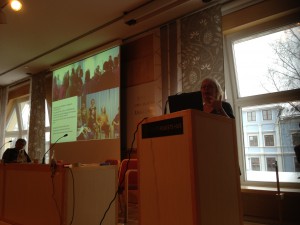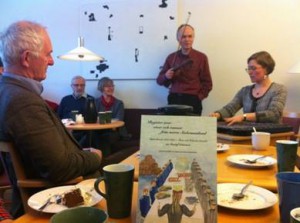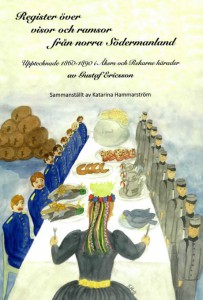Månadens bild från Svenskt visarkiv är från 1991 och föreställer jazzbasisten Red Mitchell (1927–1992), avbildad av jazzfotografen Christer Landergren.
Keith Moore Mitchell föddes i New York den 20 september 1927. Han visade tidigt intresse för musik. Under uppväxten i New Jersey, blev han uppmuntrad av sina föräldrar att satsa på musik. Efter nio år av pianolektioner, fyra år av altsax och klarinett, började han spela bas i armén 1947.
Den 8 november 1992 dog Red Mitchell av en stroke bara 10 månader efter att han och hans fru Diane, hade återvänt till USA från Sverige, där han hade varit bosatt sedan 1968.
Läs Doug Ramseys text om Red Mitchell nedan, som också ingår i CD-skivan What I Am med Red Mitchell som är utgiven på Caprice Records.
Following his social and political impulses, in 1968 Red Mitchell moved from the United States to Sweden. His 24 years in Scandinavia were among the most fulfilling in the life and career of a man honored for the brilliance of his music making. In his book Cats of Any Color, Gene Lees quoted Mitchell’s account of discovering his compatibility with Sweden. It happened when he was 27 years old and on tour with a group of musicians that included Billie Holiday.
“We were being driven around Stockholm the first day in a stretch limousine,” Mitchell told Lees. “Billie thought they were just showing us the nicer parts of town. She said, ‘Take us to the slums, I want to see the slums.’ Somebody said, “There are no slums.’ And she said, ‘What?’
“And somebody else said, ‘There’s no Beverly Hills, either.’
“And then I reacted to that. I said, ‘No slums, no Beverly Hills? Is this just Stockholm you’re talking about?’
“They said, ‘No, it’s like that all around Sweden—every city.’
“I thought, ‘Jesus! Dis mus’ be de place.”
That was in 1954. Fourteen years later, Mitchell became one of several expatriate American musicians who left behind what he described to Lees as “the institutionalization of violence and racism” in the US in the late 1960s. He emphasized that he was also attracted to Sweden by the cultural atmosphere, including the quality of the country’s jazz artists and its classical musicians. He made close connections in the Stockholm jazz community, and he expanded beyond the playing that had made him one of the most honored bassists of his generation. Long admired by his colleagues for his verbal and literary skills, over the years Mitchell had occasionally sung original songs with lyrics reflecting his humanism and his dedication to an emerging environmental movement. His Caprice albums gave him important outlets for all of his skills—on the bass, at the piano and as composer and lyricist.
By the time he recorded What I Am a decade after his arrival in Sweden, Red had become more than just another transplanted American musician escaping benighted politics and an unfair social system. His widow Diane, a fellow American whom he met in Sweden, told me, “He realized that he had to say hello to the Swedish people if he was going to get enough recognition.” He took a job in the house band on a popular television talk show. On occasion, the host would interview him. Diane said, “Red loved to talk. That’s how people got to know him outside of the jazz world, so that he was considered one of those icons of Swedish entertainment life at the time, playing with people like Monica Zetterlund and Svend Asmussen and a lot with Alice Babs, who was really the big national jazz star.
With this album and Blues For a Crushed Soul by the quintet he named Communication, Red’s presence in Sweden grew. Trumpeter Bosse Broberg remembers the pleasure of working with Red.
“His emotional gifts were indeed tremendous, emerging from his comprehension of the word ‘communication,’ for him a term with many dimensions, angles and facts of human and universal nature. Musically, I learned from Red to expand my modest ambitions into directions I didn’t imagine being able to achieve. Besides Red was also one of the most humorous persons I´ve had the privilege to know and you can easily trace that in his wonderful philosophical lyrics. Of course on top of this, his music has a very special ‘tinge.’”
Elsewhere in this CD package you will find Red’s appreciation of Broberg and the other members of Communication.
Red’s “The Sun and the Water,” helped stimulate the country’s growing environmental consciousness and became a hit. Still, Diane remembers, “The general public probably didn’t realize how much value he put on his songs and his poetry.” Public awareness increased when Red began playing piano and singing his songs in the bar of the Stortorgskällaren restaurant on the square in old town Stockholm. Then, following the success of his Caprice solo album Home Suite CAP 21313, the company arranged for two concert tours of Sweden.
“They hired me to be the roadie,” Diane said. “It was just Red and me and the sound system, and we traveled around to 44 little towns where they had small libraries or art museums, nice intimate settings. It was terrific. That was when he was really at one with himself, playing the bass and being able to go to the piano and sing. He really wanted to communicate his thoughts. He was a great poet, and he was funny. You can hear it in the lyrics. The biggest thing I miss about not having him here is that we used to laugh all the time. When you live alone, you’re not laughing as much, you know, but he used to have me on the floor laughing.”
In 1992, Red and Diane returned from Sweden to the United States. They chose another haven, the Pacific Northwest, where many prominent musicians were seeking refuge from the pressures of life in New York and Los Angeles. From their new home in Salem, Oregon, Red played engagements up and down the west coast. Some resulted in recordings, among them splendid duo albums with pianists Roger Kellaway and George Cables, and one with guitarist Joe Beck. In late October, Red had a mild heart attack that put him in the hospital. Released, he celebrated a favorable report on his health and, on November 3, the election of Bill Clinton as president of the United States. That night, he had a stroke and fell into a coma. Five days later, he was gone.
/Doug Ramsey
Doug Ramsey is the author of the award-winning Take Five: The Public and Private Lives of Paul Desmond. He blogs about jazz and other matters at Rifftides.
Läs mer om Caprice Records utgivning av What I am
Läs mer om Red Mitchell




